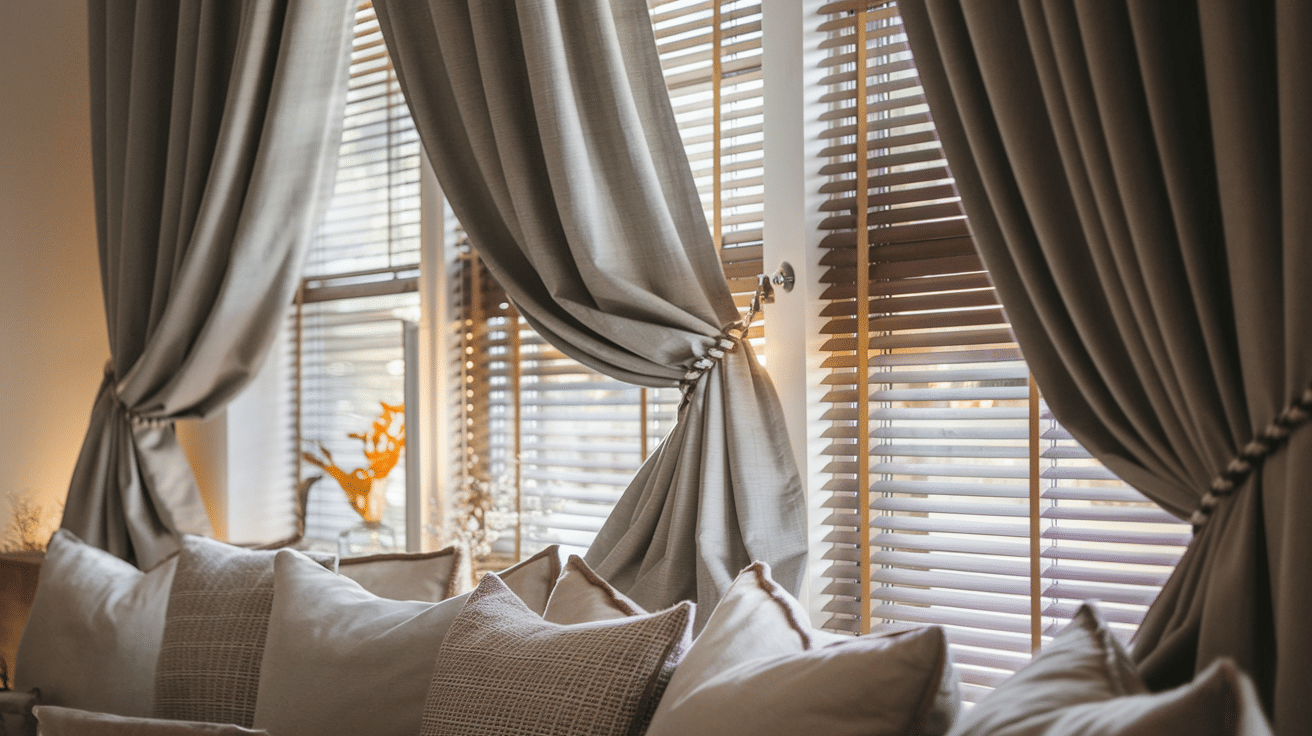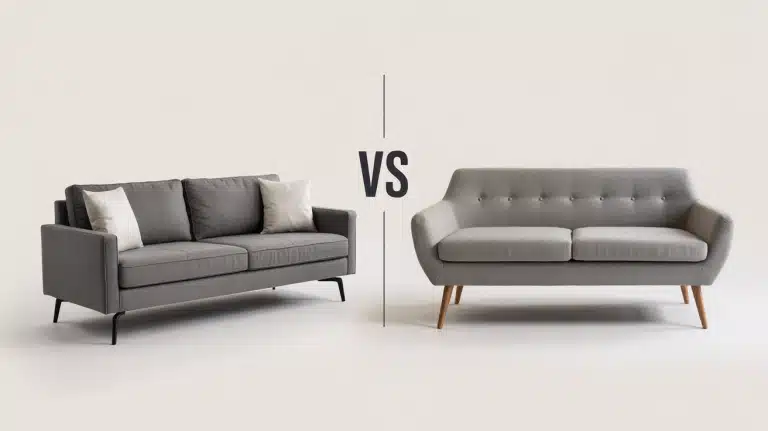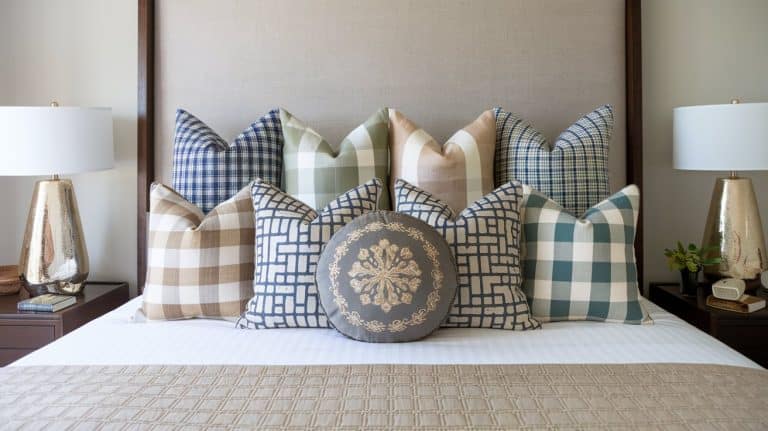How to Hang Curtains Over Blinds for a Alluring Look
Are you looking at your blinds and thinking they seem too plain? You’re not alone. Many homeowners feel the same way about their window treatments.
The good news is that you don’t need to choose between looks and purpose—you can enjoy both! Adding curtains over blinds brings warmth and style to any room without sacrificing the light control they offer.
In this guide, I’ll show you how to add curtains over blinds correctly. You’ll learn which fabrics work best, how to hang them properly, and the common errors most people make.
When you finish reading, you’ll know exactly how to turn your windows from basic to beautiful. Ready to change how your rooms look and feel? Let’s get started!
Steps to Hang Curtains Over Blinds
These six simple steps will help you add curtains over your existing blinds. The process is straightforward and can transform your room quickly.
Step 1: Measure Your Windows Properly
Getting the right measurements is crucial for a successful curtain-hanging project. Start by measuring your window width accurately. Once you have that measurement, add 4-6 inches on each side of the window for the curtain rod.
This extra width not only allows the curtains to hang properly but also helps to maximize light control and enhance the overall aesthetic of your space. It’s also important to consider the height at which you’ll install the rod.
Step 2: Choose the Right Curtain and Blind Combination
Light-filtering curtains work well in living spaces. They allow soft natural light to create a warm and inviting atmosphere while still offering some privacy.
Pick curtain colors and textures that complement your blinds for a cohesive look. Neutral blinds pair beautifully with patterned curtains to add visual interest, while textured blinds work best with solid-colored curtains to maintain a balanced and elegant aesthetic.
Step 3: Select the Right Mounting Method
No-drill options are perfect for those who want to avoid drilling holes in their walls while still achieving a beautiful window treatment. One solution is Command hooks, which can support lightweight curtains.
These hooks come in various sizes and are designed to hold a reasonable weight, making them ideal for sheer or light fabric. Another alternative is using headrail brackets that clip onto the blinds, this option allows you to easily attach curtains to your existing window treatments without the hassle of a drill
Step 4: Install Brackets or Hooks
For no-drill brackets, clip them onto the top edge of your blind headrail, ensuring a secure fit. Make sure they’re evenly spaced to support the rod’s weight and prevent sagging in the middle.
Wall-mounted brackets require precise placement for a balanced look. Mark your drill spots with a pencil first, double-checking measurements to ensure accuracy. Install the brackets at the same height on both sides of the window to keep the rod level.
Step 5: Hang the Curtains
Once the curtains are threaded onto the rod, adjust the folds to create a neat and uniform drape. Take your time with this step, as a well-arranged curtain enhances the room’s overall mood.
After adjusting the folds, gently pull both sides of the curtain down. This will help you check for balance in the curtains’ hanging. Make necessary adjustments to ensure that both sides are aligned and hang evenly.
Step 6: Final Adjustments and Styling
Test that the blinds and curtains still work without catching. The blinds should raise and lower easily, and the curtains should open and close without snagging.
For the best look, leave the blinds partially open when the curtains are drawn back. This creates layers and adds depth to your window treatment. With the right adjustments, your blinds and curtains will work seamlessly together.
Do’s and Don’ts of Hanging Curtains Over Blinds
Knowing what works and what doesn’t will save you time and money. Here are some practical tips to help you make smart choices.
Do’s: What Works Best
- Pick neutral or complementary colors for a cohesive look. Colors that work together create a sense of unity in your room design.
- Blackout curtains provide privacy and insulation. They block light and help keep rooms warmer in winter and cooler in summer.
- If you’re renting, choose sturdy no-drill brackets. These options protect your security deposit while still allowing you to upgrade your style.
- Layer sheer curtains for a soft, elegant look. This adds texture and lets you control light levels throughout the day.
- Consider motorized blinds for modern convenience. They pair well with curtains and make daily adjustments much easier.
Don’ts: Common Mistakes to Avoid
- Avoid using tension rods as they interfere with blind movement. They can slip when curtains are pulled and may damage your blinds.
- Don’t use heavy prints on both blinds and curtains. This can create visual confusion and make your windows look too busy.
- Avoid mounting blinds outside the window frame. This approach looks messy and reduces the clean lines of your window treatment.
- Don’t choose the same curtain type for every room. Each space has different light needs and functions that require specific solutions.
- Avoid thin, weak adhesive hooks that cannot handle curtain weights. They will eventually fail, causing damage and frustration.
Benefits of Layering Curtains Over Blinds
Adding curtains over blinds creates many practical advantages beyond looks. The combination offers solutions that neither option alone can provide.
1. Light and Privacy Control
Combining blackout curtains and blinds gives you ultimate flexibility. Blinds let you direct light while maintaining privacy, while curtains can block light completely when needed. Together, they offer full control at any time of day.
You can tilt blinds to scatter harsh sunlight while keeping curtains open or closed for total darkness. This dual system makes rooms more useful throughout changing seasons and times of day.
2. Energy Efficiency & Insulation
Curtains help keep rooms cool in summer and warm in winter. The air pocket between curtains and blinds works as extra insulation. This layer traps heat in winter and blocks it in summer, potentially lowering energy bills.
Thick or thermal curtains can reduce heat loss through windows by up to 25%. This extra layer works like a blanket for your windows, creating a buffer zone that stops drafts and heat transfer.
3. Acoustic Insulation
The soundproofing benefits are ideal for street-facing rooms. Thick curtains absorb sound waves that pass through windows. This buffer reduces noise from traffic, neighbors, and outdoor activities. The result is a quieter, more peaceful indoor space.
Heavy fabrics like velvet or lined cotton create the best sound barriers. When paired with blinds, they can reduce outside noise levels by several decibels, making them perfect for bedrooms or home offices.
4. Enhanced Aesthetic Appeal
This combination turns basic windows into a design feature. Curtains add color, texture, and movement to otherwise flat window treatments. They soften the hard lines of blinds and frame your views. This simple upgrade can become the focal point of your room.
The layered look creates depth and interest, much like layering in clothing fashion. You can change curtains seasonally while keeping blinds constant, allowing easy style updates without major renovations.
Final Thoughts
You’ve now seen how curtains and blinds can solve multiple problems simultaneously. This pairing isn’t just about looks—it’s practical magic for your windows.
For renters, the no-drill options mean you can enjoy these benefits without losing your deposit: quick changes, big impact, and no commitment needed.
Don’t feel stuck with the first combination you try. Swap out curtains seasonally or as your taste changes. The blinds provide a constant base while your fabric choices can evolve.
What works in your bedroom might not suit your living room. Each space deserves its thoughtful treatment. Trust your eye and your comfort needs above any design rules.
Your windows frame your view of the world. Why not frame them beautifully in return?













